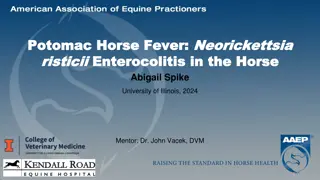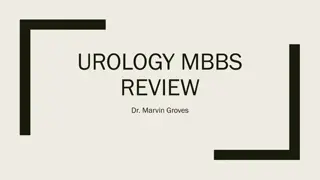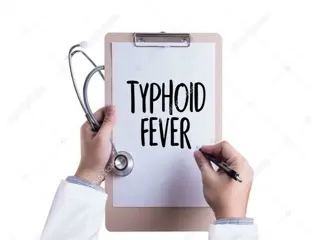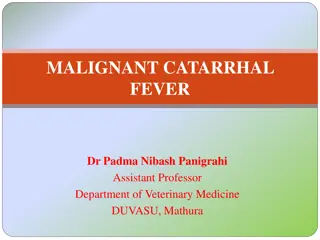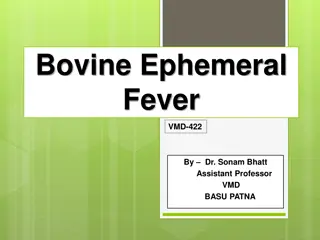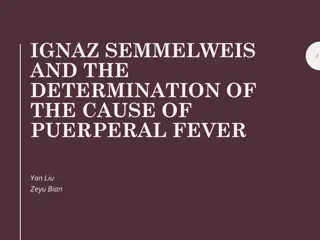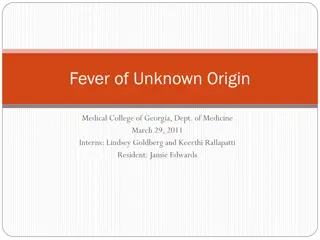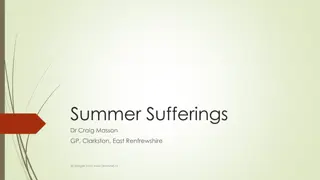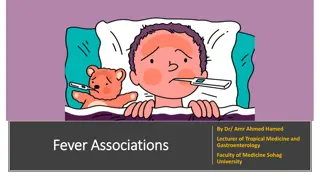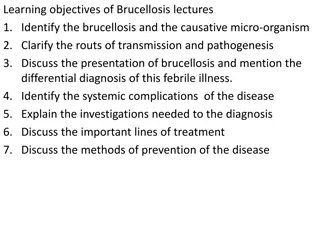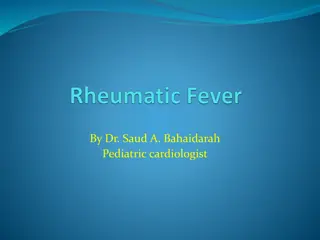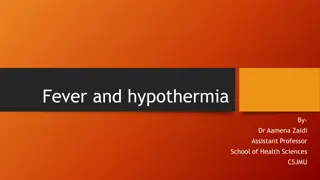
Acute Rheumatic Fever
Learn about the incidence, pathogenesis, clinical features, and diagnosis criteria of acute rheumatic fever triggered by immune response to streptococcal infection. Recognize the major and minor manifestations according to the Jones criteria for diagnosis in children and young adults. Increase awareness of this condition that can lead to acquired heart disease in childhood and adolescence.
Download Presentation

Please find below an Image/Link to download the presentation.
The content on the website is provided AS IS for your information and personal use only. It may not be sold, licensed, or shared on other websites without obtaining consent from the author. If you encounter any issues during the download, it is possible that the publisher has removed the file from their server.
You are allowed to download the files provided on this website for personal or commercial use, subject to the condition that they are used lawfully. All files are the property of their respective owners.
The content on the website is provided AS IS for your information and personal use only. It may not be sold, licensed, or shared on other websites without obtaining consent from the author.
E N D
Presentation Transcript
Acute rheumatic fever Dr. Zaki Bettamer Zikoecho@yahoo.com 4/15/2025 11:26 AM
14 years old female with Rt. Knee pain and swelling 2 days duration , before 3days was in her ankle and subsided ass. with fever . h/o URTI 2 wks back. O/E : T 38.5 c, Rt. Knee arthritis. Other wise normal. ECG normal, WBC 15 x !0^3, ESR 105.
Incidence and pathogenesis The condition is triggered by an immune- mediated delayed response to infection with specific strains of group A streptococci, which have antigens that may cross-react with cardiac myosin and sarcolemmal membrane protein.
Antibodies produced against the streptococcal antigens cause inflammation : endocardium, myocardium and pericardium. joints and skin.
Children ( 5 15 y ) or young adults very rare (Western Europe and North America) remains endemic ( parts of Asia, Africa and South America ) annual incidence ( >100 per 100 000 ) most common cause of acquired heart disease in childhood and adolescence.
Clinical features Fever. Anorexia. lethargy . joint pain. 2 3 weeks after an episode of streptococcal pharyngitis.
Dignosis two or more major manifestations or one major and two or more minor manifestations along with evidence of preceding streptococcal infection.
Jones criteria for the diagnosis of rheumatic fever Major manifestations Carditis Polyarthritis Chorea Erythema marginatum Subcutaneous nodules Minor manifestations Fever Arthralgia Previous rheumatic fever Raised ESR or CRP Leucocytosis First-degree AV block
Plus Supporting evidence of preceding streptococcal infection, recent scarlet fever, raised antistreptolysin O or other streptococcal antibody titre, positive throat culture.
Carditis pancarditis. declines with increasing age. breathlessness . palpitations or chest pain. Tachycardia. cardiac enlargement new or changed murmurs ( MR ).
A soft mid-diastolic murmur (the Carey Coombs murmur) Aortic regurgitation ( 50% ) tricuspid and pulmonary valves (rare) Pericarditis may cause chest pain, a pericardial friction rub and precordial tenderness. Cardiac failure may be due to myocardial dysfunction or valvular regurgitation. ECG changes commonly include ST and T wave changes. Conduction defects sometimes occur and may cause syncope.
Arthritis most common major manifestation and occurs early when streptococcal antibody titres are high. An acute painful asymmetric and migratory inflammation of the large joints typically affects the knees, ankles, elbows and wrists. The joints are involved in quick succession and are usually red, swollen and tender for between a day and 4 weeks. The pain characteristically responds to aspirin; if not, the diagnosis is in doubt.
Skin lesions Erythema marginatum ( < 5% ). The lesions start as red macules that fade in the centre but remain red at the edges (trunk and proximal extremities ) . The resulting red rings or margins may coalesce or overlap . Subcutaneous nodules ( 5 7% ) . small (0.5 2.0 cm), firm and painless, and are best felt over extensor surfaces of bone or tendons. typically appear more than 3 weeks after the onset of other manifestations (confirm rather than make the diagnosis ). pleurisy, pleural effusion and pneumonia ( rare ).
Sydenhams chorea late neurological manifestation that appears at least 3 months after the episode of acute rheumatic fever, when all the other signs may have disappeared. occurs 1/3 of cases and is more common in females. Emotional lability may be the first feature and is typically followed by purposeless, involuntary, choreiform movements of the hands, feet or face. Speech may be explosive and halting. Spontaneous recovery usually occurs within a few months. Approximately one-quarter of affected patients will go on to develop chronic rheumatic valve disease.
Investigations in acute rheumatic feve Evidence of a systemic illness (non-specific) Leucocytosis, raised ESR and CRP Evidence of preceding streptococcal infection (specific) Throat swab culture: group A -haemolytic streptococci . Antistreptolysin O antibodies (ASO titres): rising titres, or levels of > 200 U (adults) or > 300 U (children)
Evidence of carditis Chest X-ray: cardiomegaly, pulmonary congestion ECG: first- and rarely second-degree AV block; features of pericarditis; T-wave inversion; reduction in QRS voltages Echocardiography: cardiac dilatation and valve abnormalities
Investigations The ESR and CRP are useful for monitoring progress of the disease . Positive throat swab cultures are obtained in only 10 25% of cases. ASO titres are normal in one-fifth of adult cases of rheumatic fever and most cases of chorea. Echocardiography ( MR with dilatation of the mitral annulus and prolapse of the anterior mitral leaflet), and may also show aortic regurgitation and pericardial effusion.
Management of the acute attack A single dose of benzyl penicillin (1.2 million U IM) or oral phenoxymethylpenicillin (250 mg 4 times daily for 10 days) should be given on diagnosis to eliminate any residual streptococcal infection. penicillin allergic (erythromycin or cephalosporin ). Treatment is then directed towards limiting cardiac damage and relieving symptoms.
Bed rest and supportive therapy Bed rest is important for joint pain and reduces cardiac workload. The duration should be guided by symptoms, along with temperature, leucocyte count and ESR, and should be continued until these have settled. Patients can then return to normal physical activity but strenuous exercise should be avoided in those who have carditis.
Cardiac failure should be treated as necessary. particularly in early adolescence, develop a fulminant form of the disease with severe MR and AR If not respond to medical treatment, valve replacement may be necessary and is often associated with a dramatic decline in rheumatic activity. AV block is seldom progressive and pacemaker insertion rarely needed.
Aspirin This usually relieves the symptoms of arthritis rapidly and a response within 24 hours helps confirm the diagnosis. A reasonable starting dose is 60 mg/kg body weight/day, divided into six doses. In adults, 100 mg/kg per day may be needed up to the limits of tolerance or a maximum of 8 g per day. Mild toxicity includes nausea, tinnitus and deafness; vomiting, tachypnoea and acidosis are more serious. Aspirin should be continued until the ESR has fallen, and then gradually tailed off.
Corticosteroids These produce more rapid symptomatic relief than aspirin and are indicated in cases with carditis or severe arthritis. There is no evidence that long-term steroids are beneficial. Prednisolone (1.0 2.0 mg/kg per day in divided doses) should be continued until the ESR is normal, and then tailed off.
Secondary prevention susceptible to further attacks of rheumatic fever if another streptococcal infection occurs. longterm prophylaxis with penicillin should be given as benzathine penicillin (1.2 million U IM monthly). if compliance is in doubt, oral phenoxymethylpenicillin (250 mg twice daily). allergic to penicillin ( Sulfadiazine or erythromycin )
sulphonamides prevent infection , not effective in the eradication Further attacks unusual after the age of 21. it should be extended if an attack has occurred in the last 5 years, or if the patient lives in an area of high prevalence or has an occupation with high exposure to strep. infection. In those with residual heart disease, prophylaxis should continue until 10 years after the last episode or 40 years of age, Long-term antibiotic prophylaxis prevents another attack of acute rheumatic fever but does not protect against infective endocarditis.
Chronic rheumatic heart disease Chronic valvular heart disease develops in at least 1/2 of those affected by Rh. fever with carditis. 2/3 of cases occur in women. Some episodes of Rh. fever pass unrecognised and it is only possible to elicit a history of Rh. fever or chorea in about half of all patients with chronic rheumatic heart disease. The MV is affected in more than 90% . the AV is the next most frequently involved, then TV and then PV. Isolated MS accounts for about 25% of all cases, and an additional 40% have mixed MS and MR. Valve disease may be symptomatic during fulminant forms of acute Rh. fever but may remain asymptomatic for many years.
Pathology the main pathological process in chronic RHD is progressive fibrosis. The heart valves are predominantly affected but involvement of the pericardium and myocardium may contribute to HF and conduction disorders. Fusion of the mitral valve commissures and shortening of the chordae tendineae may lead to MS with or without MR . Similar changes in the AV and TV produce distortion & rigidity of the cusps, leading to stenosis and regurgitation. Once a valve has been damaged, the altered haemodynamic stresses perpetuate and extend the damage, even in the absence of a continuing rheumatic process.

